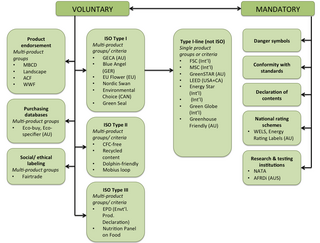Examples
Carbon Trust Standard

The Carbon Trust Standard is an independent certification scheme from The Carbon Trust, certifying an organisation's impact in respect of:
- Energy usage and greenhouse gas (CO2e) emissions
- Water usage, management and effluent
- Waste management and disposal.
Its stated aim is to recognize best practice and real achievements in reduction, to help organisations to measure, manage and reduce their environmental impact, whilst improving their resource management and operational sustainability. The certification process aims to identify inefficiencies in resource use and to provide a framework for improving management processes, reducing waste and costs. As of July 2014, over 1,100 organisations have certified with the Carbon Trust Standard. [10]
EMAS
The Eco-Management and Audit Scheme (EMAS) is the EU's voluntary environmental resources management instrument. Environmental Management Systems in accordance with EMAS are used worldwide by companies and organisations of all sizes and types. EMAS registered organisations commit themselves to evaluate, manage and improve their environmental performance. EMAS is open to every type of organisation attempting to improve its environmental performance. It spans all economic and service sectors and is applicable worldwide. Currently, more than 4,400 organisations and more than 8,150 sites are EMAS registered. [11] Only independent environmental verifiers that are accredited/licensed and supervised by government authorities (Accreditation or Licensing Bodies) are authorised to validate EMAS environmental statements. The external and independent nature of the EMAS registration process ensures the credibility of the scheme and the reliability of the information provided by registered organisations. The ISO 14001: 2004 requirements are a part of EMAS, but EMAS adds several elements to these:
- stricter requirements on the measurement and evaluation of environmental performance against set targets according to six environmental core indicators, and the continuous improvement of that environmental performance;
- compliance with environmental legislation ensured by government supervision: the compliance check is executed by an independent and external environmental verifier, who is in turn subjected to quality checks by national government authorities (EMAS Competent Bodies, EMAS Accreditation Bodies);
- requirement of employee involvement in the continuous performance improvement process;
- provision of information to the general public through the obligation to publish an annual public environmental statement that is independently verified;
- registration by a public authority after verification by an accredited/licensed environmental verifier; and
- registered organisations can use the EMAS logo to communicate their EMAS compliance
More than 80 percent of all EMAS registered organizations are small and medium-sized organisations (SMEs). [12] EMAS has specific provisions in place to facilitate EMAS registration for SMEs. For example, EMASeasy, a lean and standardised methodology, has been developed to facilitate the participation of small and micro businesses in the EMAS Scheme.
Forest Stewardship Council (FSC)

The Forest Stewardship Council (FSC) is a non-profit, nongovernmental organization (NGO) which promotes the responsible management of forests on an international scale. It is widely regarded as one of the most important initiatives for promoting responsible international forest management and was established in 1993 following concerns for global deforestation. [13] The FSC is a voluntary mechanism which involves an inspection of a forest landowners management practices based on criteria for sustainable forest management. This can occur on both privately and publicly owned forests and allows the products manufactured from certified forests to be tracked through the value chain. [11] Certificates are not issued by the FSC but by third party independent organisations called certification bodies. These bodies assess the forest management against FSC standards and audits certificate holders at least once a year to ensure continued compliance with FSC standards. To achieve official recognition as an FSC certification body they must comply with a large set of rules and procedures and also be verified by Accreditation Services International (ASI), the company managing the FSC accreditation program. [13]
The FSC provides a globally recognized private standard, trademark assurance and accreditation services for companies, organizations and communities interested in responsible forestry. Products that have been certified can be identified by consumers from the on product ecolabel which provides a globally trusted mark of forest products that benefit people and the environment. [4] [13] This helps a company to protect a brand or reputation and allows certificate holders access to highly environmentally sensitive markets. [13] This provides an example of mainstreaming strategy shaped by retailer dominance of wood commodity networks as it has been supported by the World Bank, USAID, several European governments, influential environmental organizations, and by transnational retailers such as IKEA and The Home Depot and has especially strong market penetration in the United Kingdom, Germany and on the Dutch timber market. [14] [15]
The fundamental purpose of the FSC is to allow environmentally aware consumers to use market forces to effectively complement and develop forest policy and to ensure that producer behave in a responsible way according to predefined objectives. As a result of this the FSC has been endorsed by influential NGOs as a means to promote concrete actions regarding forest management, as a platform for stating forest policy principles and values, and as an effective way to gain publicity. [16] The potential benefits of the FSC are said to include ecological, economic and social aspects, therefore the sustainability of forests. [16] The environmental certification process commits forest managers to make improvements to planning and monitoring, implement conservation strategies, reduce the environmental impact from logging and improve the conditions of forest workers. [15] It also demonstrates the success of NGOs in promoting rapid adoption of environmental certification which pushes social and environmental improvements in forest management practices. [14]
There have been concerns that the retailer-focused expansion strategy tends to favour large forest enterprises over small ones, northern operations over southern ones, and may be unable to meet the special needs of community forest managers. [14] There has also been a concern that the certification process leaves the burden of costs of both the certification process and wood that is more expensive to produce on the producer without allowing them to charge a higher price for FSC certified products. [15]
ISO 14001

The ISO 14001 is a voluntary international standard created in 1996 by the International Organization for Standardization (ISO) and forms part of the ISO 14000 series of environmental standards. [3] This came about as a result of the Uruguay round of the GATT negotiations and the Rio Summit on the Environment held in 1992. At the Uruguay round of the GATT negotiations the need to reduce the non-tariff barriers to trade were discussed whereas at the Rio Summit the commitment to protect the environment at an international scale was argued. [17] This brought about the ISO 14001 which allows firms to inform stakeholders of the implementation of an Environmental Management System (EMS) and specifies the actual requirements for an EMS. [17] The ISO 14001 standard defines EMS as "the general part of management that includes the organizational structure, the activity planning, the responsibilities, the practices, the procedures, the processes and the resources to develop, implement, carry out, and revise the environmental policy and keep it up to date". [7]
Similarly to the FSC, ISO 14001 certification can be issued by any third party certification body, but to prove credibility, such bodies should be accredited (to offer ISO 14001 certification) by organisations such as JAS-ANZ, ANAB, UKAS, and others. These accreditation bodies audit the certification bodies to ensure that the assessment and certification processes are robust and free from conflicts of interest. It provides guidelines and suggestions for matters such as environmental management, environmental auditing, and environmental labelling or lifecycle assessment. [3] It applies to all organisations large or small and covers all sectors if there are environmental aspects that the organisation can control and influence in a positive way. [17] There are other environmental management system standards that, while addressing the requirements of ISO 14001, have other additional benefits. For example, the Eco Warranty standard not only meets the requirements of ISO 14001 but also allows use of the certification logo; this is not allowable with accredited ISO 14001 certification.
The implementation of an EMS can be an appropriate step for those companies wanting to move towards a more environmentally aware position. [3] It shows companies how to measure their consumption and reduce waste, also how they can effectively reduce, re-use and recycle to make savings costs, reduce environmental impacts and enhance their environmental credentials. Many organisations that choose to adopt the ISO 14001 are trying to achieve preferred supplier status as it is now often a competitive advantage or a requirement for local authorities or for a supply chain. [17] The benefits of having ISO 14001 certification are seen to be, better management of environmental risks, both now and in the future, increased access to new customers and business partners, demonstration of legal and regulatory compliance, [18] potential for reduced public liability insurance costs and overall cost savings through the reduction of consumption and waste and through recycling. [17] Although this does not guarantee a specific level of improvement in environmental performance there is empirical evidence to suggest that this standard does help to improve the environmental performance of an organisation. [7]
In paper from Environmental Coalition on Standards (ECOS) it explains the "ISO 2030 Strategy does make commitments on inclusiveness that, if implemented ambitiously, will make ISO the front-runner in inclusiveness, both for the standards they develop and their governance." [19]
MCERTS
Business emissions into air, land and water are regulated under strict European and UK laws, to protect the environment and human health. If a company in England or Wales needs to comply with these laws it will need a permission from the Environment Agency to operate. This permission usually comes in the form of a permit, which usually requires it to monitor its emissions.
Businesses either monitor their emissions all the time, known as continuous monitoring, or at times defined in their permit, known as spot tests or periodic monitoring. In both cases they must meet EA quality requirements.
MCERTS is the Environment Agency's Monitoring Certification Scheme. It provides the framework for businesses to meet EA quality requirements. If it complies with MCERTS then the EA can have confidence in the monitoring of emissions to the environment.
MCERTS is used to approve instruments, people, laboratories and Environmental Data Management Systems (EDMS). [20] [21]
Blue Planet Friendly certification

Blue Planet Friendly is an environmental certification delivered by a French non-profit organization that serves a global movement for assessing and reducing the pollution generated by companies and cities.
The companies and cities certified prove emission reductions by product or inhabitant on a year basis and receive a certification with a level (bronze, silver or gold). Each company or city is physically audited every year. [22]










